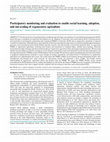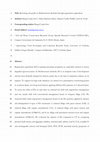Papers by Raquel Lujan Soto
Zenodo (CERN European Organization for Nuclear Research), Jul 14, 2022
Journal of Rural Studies, Dec 1, 2021
Frontiers in Sustainable Food Systems

Ecology and Society, 2021
The advanced state of land degradation worldwide urges the large-scale adoption of sustainable la... more The advanced state of land degradation worldwide urges the large-scale adoption of sustainable land management (SLM). Social learning is considered an important precondition for the adoption of innovative and contextualized SLM. Involving farmers and researchers in participatory monitoring and evaluation (PM&E) of innovative SLM such as regenerative agriculture is expected to enable social learning. Although there is a growing body of literature asserting the achievement of social learning through participatory processes, social learning has been loosely defined, sparsely assessed, and only partially covered when measured. Here, we assess how PM&E of regenerative agriculture, involving local farmers and researchers in southeast Spain, enabled social learning, effectively increasing knowledge exchange and shared understanding of regenerative agriculture effects among participating farmers. We measured whether social learning occurred by covering its social-cognitive (perceptions) and social-relational (social networks) dimensions, and discussed the potential of PM&E to foster SLM adoption and out-scaling. We used fuzzy cognitive mapping and social network analysis as graphical semiquantitative methods to assess changes in farmers' perceptions and shared fluxes of information on regenerative agriculture over approximately three years. Our results show that PM&E enabled social learning among participating farmers, who strengthened and enlarged their social networks for information sharing and presented a more complex and broader shared understanding of regenerative agriculture effects and benefits than pre PM&E. We argue that PM&E thereby creates crucial preconditions for SLM adoption and out-scaling. Our findings are relevant for the design of PM&E processes, living labs, and landscape restoration initiatives that aim to support farmers' adoption and out-scaling of innovative and contextualized SLM.

Agriculture, Ecosystems & Environment, 2021
Regenerative agriculture (RA) is gaining increasing recognition as a plausible solution to restor... more Regenerative agriculture (RA) is gaining increasing recognition as a plausible solution to restore degraded agroecosystems. In Mediterranean drylands, RA is at incipient state of development and has been limitedly adopted by farmers, partly due to the lack of empirical evidence on its impacts. To support its large-scale adoption, we carried out a participatory monitoring project in southeast Spain, involving local farmers applying different RA practices in 9 almond farms. To assess the effect of RA, in each farm we selected one field with regenerative management and one nearby field with conventional management based on frequent tillage (CT). We clustered fields under regenerative management based on the RA practices applied by farmers and distinguished 4 types of RA treatments: 1) reduced tillage with green manure (GM), 2) reduced tillage with organic amendments (OA), 3) reduced tillage with green manure and organic amendments (GM&OA), and 4) no tillage with permanent natural covers and organic amendments (NT&OA). We evaluated the impacts of RA compared to CT by comparing physical (bulk density and aggregate stability), chemical (pH, salinity, total N, P, K, available P, and exchangeable cations) and biological (SOC, POC, PON, microbial activity) properties of soil quality and the nutritional status of almond trees (leaf N, P and K). Our results show that GM improved soil physical properties, presenting higher soil aggregate stability. We found that OA improved most soil chemical and biological properties, showing higher contents of SOC, POC, PON, total N, K, P, available P, exchangeable cations and microbial respiration. RA treatments combining ground covers and organic amendments (GM&OA and NT&OA) exhibited greater overall soil quality restoration than individual practices. NT&OA stood out for presenting the highest soil quality improvements. All RA treatments maintained similar crop nutritional status compared to CT. We conclude that RA has strong potential to restore the physical, chemical and biological quality of soils of woody agroecosystems in Mediterranean drylands without compromising crop performance, thereby enhancing their resilience to climate change and long term sustainability.

<p>Regenerative agriculture (RA) is gaining increasing recognition ... more <p>Regenerative agriculture (RA) is gaining increasing recognition as a plausible solution to restore degraded agroecosystems. In Mediterranean drylands, RA has been limitedly adopted by farmers due to its initial state of development and lack of empirical evidence on its impacts. To support its large-scale adoption, we carried out a participatory monitoring and evaluation project in the high steppe plateau of Southeast Spain, involving local farmers applying RA in their almond farms. To assess the effect of RA, we studied 9 farms and selected in each farm one field with regenerative management and one nearby field with conventional management based on frequent tillage (CT). We clustered fields under regenerative management based on the different RA practices being applied and distinguished 4 types of RA treatments: 1) reduced tillage with green manure (GM), 2) reduced tillage with organic amendments (OA), 3) reduced tillage with green manure and organic amendments (GM&OA), and 4) no tillage with permanent natural covers and organic amendments (NT&OA). We used physical (bulk density and aggregate stability), chemical (pH, salinity, total N, P, K, available P, and exchangeable cations) and biological (SOC, POC, PON, microbial activity)  soil propertoes and the nutritional status of almond trees (leaf N, P and K) to evaluate the impacts of RA compared to CT. We found that GM treatment improved physical soil properties, presenting regenerative fields higher soil aggregate stability. Our results showed that OA improved most soil chemical and biological soil properties, however physical properties remained similar. RA treatments combining ground covers and organic amendments (GM&OA and NT&OA) exhibited greater overall soil quality restoration than individual practices, improving physical, chemical and biological soil properties. NT&OA stood out for presenting the highest soil quality improvements. All RA treatments maintained similar crop nutritional status compared to CT. We conclude that RA has strong potential to restore the physical, chemical and biological quality of soils of woody agroecosystems in Mediterranean drylands without compromising their nutritional status, thereby enhancing their resilience to climate change and long term sustainability.</p>
Ecosystem Services, 2020
iii 4. Lombrices Pág.-24 5. Humedad del suelo Pág.-26 6. Temperatura Pág.-28 7. Cubierta vegetal ... more iii 4. Lombrices Pág.-24 5. Humedad del suelo Pág.-26 6. Temperatura Pág.-28 7. Cubierta vegetal Pág.-30 8. Color de la cubierta Pág.-32 9. Plantas indicadoras Pág.-36 10. Protección del suelo frente a la erosión Pág.-38 11. Capacidad de infiltración Pág.-40 12. Rendimiento del cultivo Pág.-46 12.1. Carga y crecidas Pág.-44 12.2. Escandallo y calibre Pág.-46 13. Vigor del cultivo/Color de las hojas Pág.-48 14. Fauna auxiliar-Mariquitas Pág.-51 Ficha Diagnóstico Pág. Fotos utilizadas y páginas consultadas Pág.
Zenodo (CERN European Organization for Nuclear Research), Jul 14, 2022











Uploads
Papers by Raquel Lujan Soto